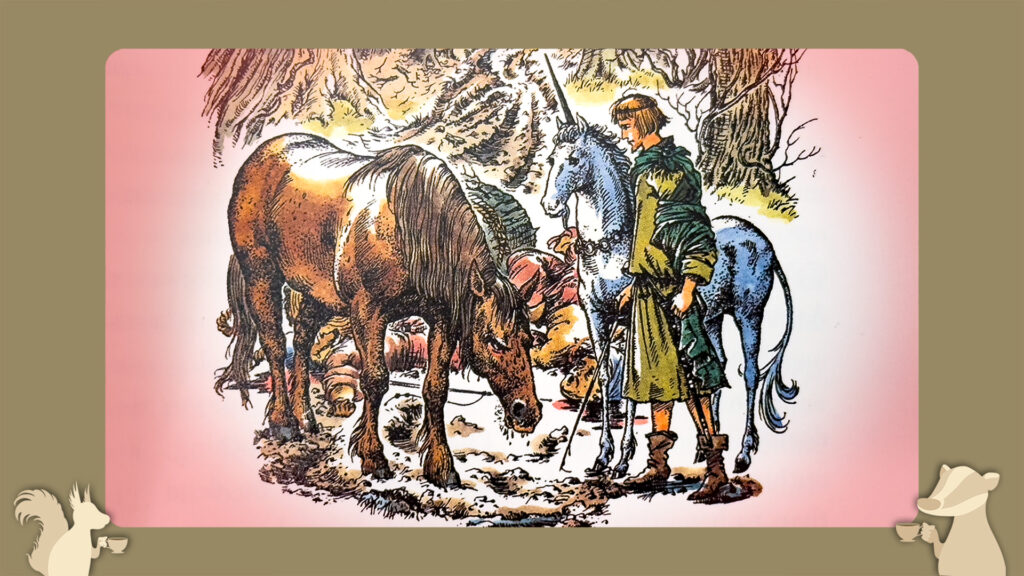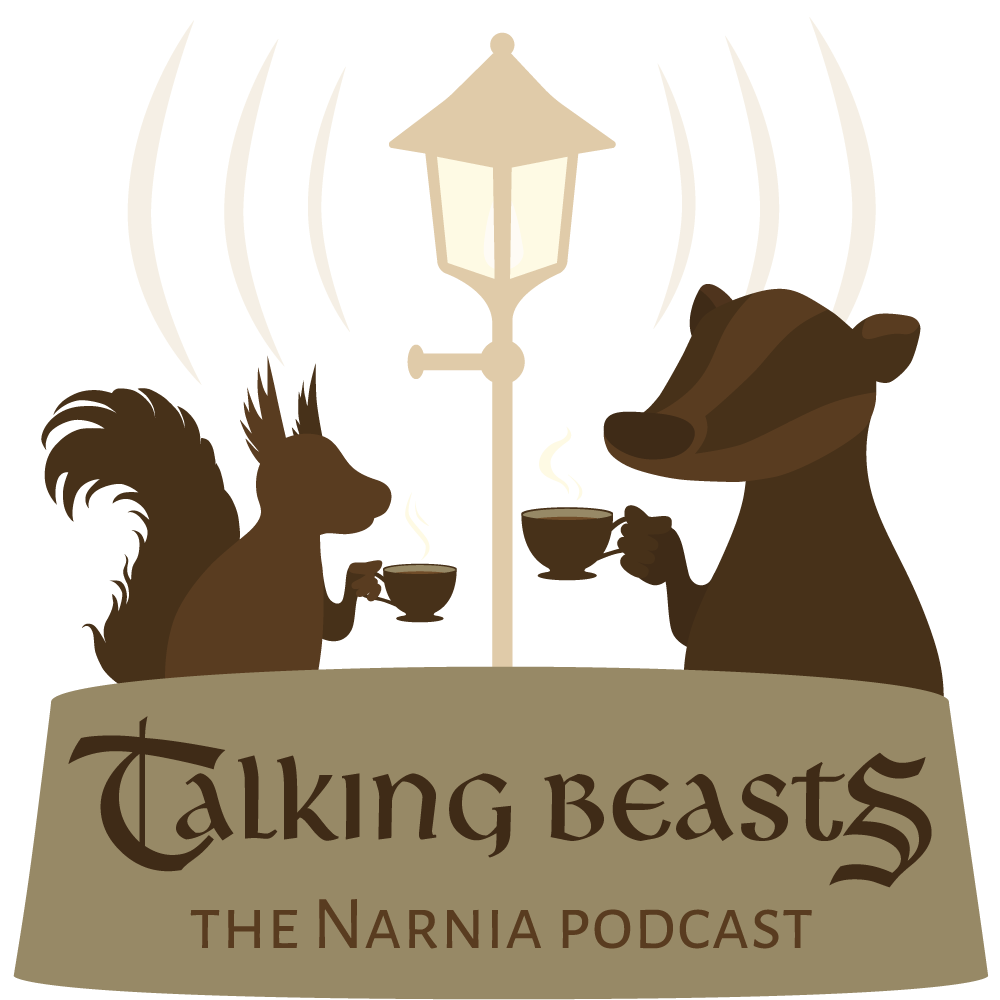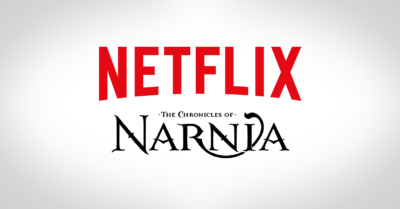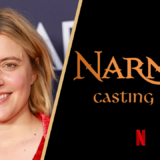PG-13 Illustration in The Last Battle? | Talking Beasts

Podcast: Play in new window | Embed
The Last Battle is a dark final turn for The Chronicles of Narnia. In chapter 2 alone, we begin with the murder of the trees at Lantern Waste and end with the main characters committing murder. Is this all this too much of a departure from the rest of the books? Listen to the conversation and then post a comment below! (Discussion about the above illustration begins at 7:53)
Also check out The Lamp-post Listener’s discussion about The Last Battle.
“Let there be wicked kings and beheadings, battles and dungeons, giants and dragons, and let villains be soundly killed at the end the book. Nothing will persuade me that this causes an ordinary child any kind or degree of fear beyond what it wants, and needs, to feel.”
C.S. Lewis, On Three Ways of Writing for Children
Watch the post-show chatter about Star Wars.







For the record, I totally see the head on the ground now. I must have been looking somewhere else during the recording.
I actually never noticed the head before until I read it again this past summer. I was reading my edition with full color illustrations and I was very surprised when I spotted it.
As for the matter of Tirian being away from Cair Paravel, I never even considered that he was being neglectful, but I always took it as a sign of his humility. It’s a good point, though. Perhaps he should’ve been more thoughtful.
In the past, whenever I read The Last Battle, when Tirian and Jewel kill the Calormens, I hardly ever questioned what they had done. Only on my last few readings did I really understand that what they had done was wrong and unwise. When talking about making the situation more questionable for a movie version, Rillian offered the idea that the Calormens actually kill the horse. If they had actually killed the horse, would the murder be any less wrong? Would that justify Tirian and Jewel?
Roonwit is the main reason why I love Centaurs so much in Narnia. The idea that they are revered as stargazers and prophets is such a cool piece of world-building. His character has so much implied depth and history, just by his first appearance in this chapter.
I don’t think I’ve ever noticed the head lying there before today. The colour version of this illustration *really* highlights it. It’s odd that Pauline Baynes included that detail, considering Lewis never explicitly said that in the text.
The darker tone in The Last Battle definitely stands out compared to earlier books, but I don’t think it’s too much of a departure. Throughout the series, we see glimpses of violence, betrayal, and the weight of moral choices, such as in The Lion, the Witch and the Wardrobe with Aslan’s sacrifice or The Silver Chair with the deadly dangers in Underland. What makes The Last Battle unique is the sense of finality—it’s the end of Narnia as we know it, so the stakes feel much higher. The destruction of the trees and Tirian’s rash action seem to reflect the growing sense of desperation in Narnia’s final days.
It’s intense, but I think Lewis intended to show that even in fantasy, the battle between good and evil can have devastating consequences. How the characters deal with these challenges adds depth to their journeys.
Curious to hear more of your thoughts on this!
The Last Battle is the culmination of a lot of “more mature” themes that are dispersed in the other books.
Susan already showed a lack of “faith” in previous books.
The elements of murder, darkness, faithlessness, etc. already happened in all of the other books.
Edmund betrayed his siblings to die.
Aslan is murdered on stone table in a sacrificial ceremony.
Jadis massacred her entire world with a single word.
In Prince Captain, Peter beheads a Telmarine
Aslan skinned Eustace alive in the de-dragoning redemption scene.
The dark island is filled with nightmares come to life.
The Silver Chair covers multiple dark themes of cannibalism, brainwashing, slavery, and bullying.
I can go on… but my point is, all
of these mature things finally come to light in the Last Battle for all to see.
It’s the Apocalypse of Narnia.
LB is one of the most masterfully done epic climaxes of a fantasy series, because it’s not afraid to pull punches at the end when it counts, to drive home its themes.
People are totally allowed to not like the book. It’s not an easy book to read.
But it is objectively a masterpiece.
I really like the distinction Rilian made between criticism of The Last Jedi and criticism of the Last Battle, how in his experience, Star Wars fans who dislike The Last Jedi have artistic criticisms of it whereas Narnia fans who dislike The Last Battle don’t think it’s a bad book per se; they just don’t personally enjoy it. That being said, in my limited experience, there are some fans out there on the internet (they’re less likely to be Narniawebbers or members of the Facebook group) who do seem to think the recurring darkness and despair of The Last Battle make it a bad book. They tend to leave comments of the this-book-desecrated-my-happy-childhood-memories variety. I don’t have a list of their names or anything though so it’s not like I can prove it. I also feel like the fans who tend to dislike it tend to be more secular (I’m so sorry for stereotyping here!) and they feel like the darkness of The Last Battle represents aspects of Christianity they find objectionable. (Maybe this is similar to how some Star Wars fans dislike the politics of The Last Jedi and find them annoyingly preachy.) But I hasten to add there are also atheists out there who love The Last Battle, even considering it their favorite Narnia book. Again though, I don’t have a list of their names. (FWIW, I do remember the name of one atheist Narnia fan who considers The Magician’s Nephew and The Last Battle his least favorite Narnia books because they strike him as more like allegories than the others: Bruce Handy, author of Wild Things: The Joy of Reading Children’s Literature as an Adult.)
Interesting idea about whether Tirian’s preference for the hunting lodge to Cair Paravel represents a character flaw of his. I agree with what Gymfan said about the subject.
Is the idea of dryads dying when their corresponding trees get cut down really a big surprise? I think it’s pretty standard for dryad mythology. Cf. the story of Erysichthon who was punished for cutting down sacred trees.
I think it’d have been harder for the Walden Media movies to sell Tirian and Jewel murdering the Calormenes as forgivable, had they gotten around to adapting The Last Battle, because those movies portrayed riding talking horses as normal. It wouldn’t have been impossible though. After all, they didn’t show any talking horses being whipped.
Anyway, I don’t feel that the emphasis on darkness and despair makes The Last Battle superior to other Narnia books, but I don’t feel that it makes them inferior to them either. It depends on what you’re in the mood to read.
Hello!
Good cheer to all on this beautiful day!!!!!
Good luck 🙂
The Last Battle is a very complex book, perhaps the most complex in comparison to the other six books! My pastor is doing a sermon series for the year on Living In The Last Days. No, I wouldn’t compare LB to other apocalyptic fiction out there. Though it is compelling.
As painful as it is to admit, I think you guys are right about the murder of the Calormenes. However, I don’t think anyone has brought up Tirian’s position as king in this. Could it be that as the king he is acting more as a judge with the right to mete out punishment? Is he acting as the Aslan-appointed defender of his people? Or as king is it just that much worse that he gave in to his outrage and acted without stopping to think? You’d expect a king to have been trained to control his emotions and act only after weighing the matter carefully.
In the illustration there could be a severed head, but it could be something else too. Could it be merely a rock that had something looking like a face on it? I hadn’t noticed this before in the picture, but Pauline Baynes generally avoided very graphic violence in her illustrations and usually kept the gore to a minimum. I think she realized that most of her audience consisted of children.
@Narnian78, well, I believe Pauline Baynes did the coloring for her own Narnia illustrations and the coloring really makes it look like a severed head. Plus, it has a turban. (Look through Jewel’s legs. Well, I wouldn’t advise looking too hard because, as you say, it’s really gross. 😉 )